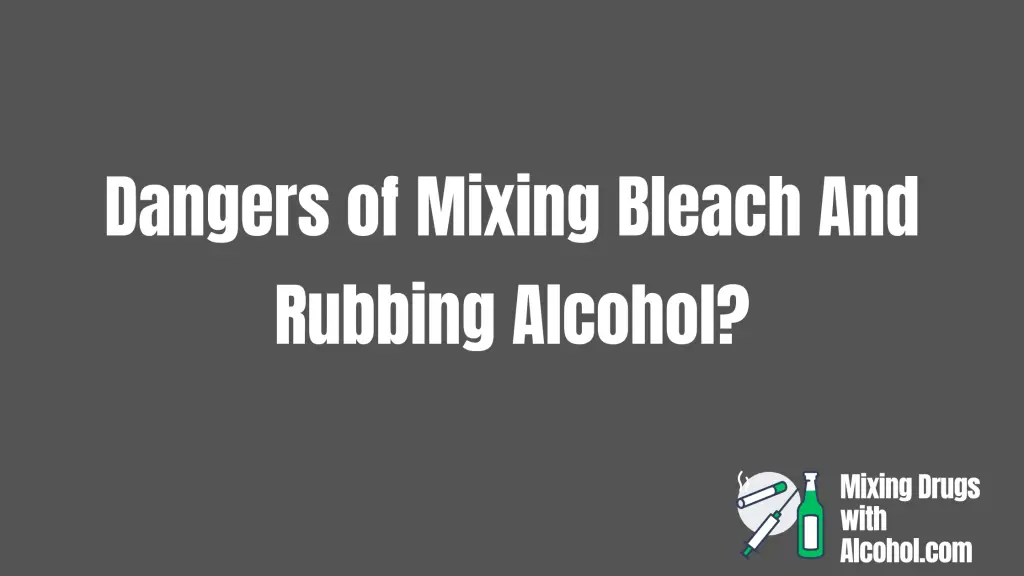Mixing bleach and rubbing alcohol is extremely dangerous and can create toxic fumes, including chloroform and hydrochloric acid, which can lead to respiratory problems, eye irritation, and even death. Even in small amounts, these chemicals can be harmful, so it’s best to avoid mixing cleaning products unless explicitly permitted. When unsure, it’s best to use cleaning agents separately and in well-ventilated areas.
What happens when you mix Bleach and Rubbing Alcohol?
Combining bleach and rubbing alcohol creates toxic fumes that can be deadly if inhaled. This reaction produces chloroform and other hazardous compounds, leading to respiratory distress, dizziness, nausea, and potentially fatal consequences. Chloroform is highly toxic to the central nervous system, liver, and kidneys. If exposed, leave the area and seek fresh air. Seek medical attention immediately if you experience any symptoms. Store household chemicals separately in ventilated areas, and carefully read labels to understand each product’s risks and precautions.
Is it Safe to Mix Bleach And Rubbing Alcohol.
Mixing bleach and rubbing alcohol can be dangerous and may lead to harmful side-effects. Here are some potential short-term and long-term effects of mixing bleach and rubbing alcohol:
Side-Effects of Mixing Bleach And Rubbing Alcohols
Mixing bleach and rubbing alcohol can be dangerous and may lead to harmful side-effects. Here are some potential short-term and long-term effects of mixing bleach and rubbing alcohol:
Short-term side effects:
- Release of toxic fumes: Mixing bleach and rubbing alcohol can produce chloroform and hydrochloric acid, which are harmful to breathe in and can cause respiratory issues, coughing, and eye irritation.
- Fire hazard: Rubbing alcohol is highly flammable, and mixing it with bleach can result in a dangerous fire hazard.
- Skin and eye irritation: The fumes produced by mixing bleach and rubbing alcohol can cause skin and eye irritation, resulting in redness, itchiness, and burning sensations.
Long-term side effects:
- Respiratory issues: Repeated exposure to the fumes produced by mixing bleach and rubbing alcohol can cause respiratory problems, such as chronic bronchitis, asthma, or pneumonia.
- Liver and kidney damage: Prolonged exposure to chloroform, one of the toxic gases produced by mixing bleach and rubbing alcohol, can lead to liver and kidney damage.
- Nervous system damage: Long-term exposure to the fumes produced by mixing bleach and rubbing alcohol can also cause damage to the nervous system, resulting in memory loss, confusion, and seizures.
It’s important to note that mixing bleach with any other cleaning products, such as ammonia or acids, can also be dangerous and should be avoided. In case of accidental mixing, it’s recommended to immediately leave the area, ventilate the space, and seek medical attention if symptoms occur.
Frequently Asked Questions About Dangers of Mixing Bleach And Rubbing Alcohol:
What happens if I mix bleach and rubbing alcohol?
Mixing bleach and rubbing alcohol creates a dangerous chemical reaction that can produce toxic gases like chloroform, chloroacetone, and hydrazine. These gases can cause respiratory problems, nausea, dizziness, and even death in severe cases.
Why is it dangerous to mix bleach and rubbing alcohol?
Bleach contains sodium hypochlorite, while rubbing alcohol contains isopropyl alcohol. When these two chemicals are mixed, they react to form chloroform and other toxic compounds. Inhaling these gases can cause serious health problems, especially in people with respiratory issues.
Can mixing bleach and rubbing alcohol cause a fire?
No, mixing bleach and rubbing alcohol doesn’t cause a fire. However, the reaction can produce flammable compounds that can ignite if exposed to heat or flames.
What should I do if I accidentally mix bleach and rubbing alcohol?
If you accidentally mix bleach and rubbing alcohol, leave the area immediately and get some fresh air. If you’re experiencing symptoms like difficulty breathing, coughing, or chest pain, seek medical attention right away.
Can I use bleach and rubbing alcohol separately for cleaning?
Yes, bleach and rubbing alcohol are effective cleaning agents when used separately. However, you should never mix them together as it can be dangerous and produce harmful gases.
What other chemicals should I avoid mixing with bleach?
You should avoid mixing bleach with ammonia, vinegar, hydrogen peroxide, or any other acid-based cleaning agents as they can also produce toxic gases. Always read the labels and use cleaning products as directed.
Centers for Disease Control and Prevention (CDC). (2021). Cleaning and Disinfecting Your Facility. Retrieved from https://www.cdc.gov/coronavirus/2019-ncov/community/disinfecting-building-facility.html
Agency for Toxic Substances and Disease Registry (ATSDR). (2019). Toxicological Profile for Chloroform. Retrieved from https://www.atsdr.cdc.gov/toxprofiles/tp6.pdf
National Institutes of Health (NIH). (2022). Household Products Database. Retrieved from https://hpd.nlm.nih.gov/cgi-bin/household/brands?tbl=chem&id=172&query=bleach&searchas=TblChemicals
The New York Times. (2020). Don’t Mix These Cleaning Products. Retrieved from https://www.nytimes.com/2020/03/25/smarter-living/coronavirus-clean-home-stay-safe.html
Occupational Safety and Health Administration (OSHA). (n.d.). Hazard Communication: Safety Data Sheets. Retrieved from https://www.osha.gov/Publications/OSHA3514.html
Similar Articles
Prednisone And Alcohol
Amoxicillin and Alcohol
Lexapro and Alcohol
Doxycycline Hyclate and Alcohol
Zoloft and Alcohol
Ibuprofen and Alcohol
Methylprednisolone and Alcohol
Antidepressants and Alcohol
Muscle Relaxers and Alcohol
Nitrofurantoin and Alcohol
Blood Thinners and Alcohol
Pfizer vaccine and Alcohol
Pantoprazole and Alcohol

